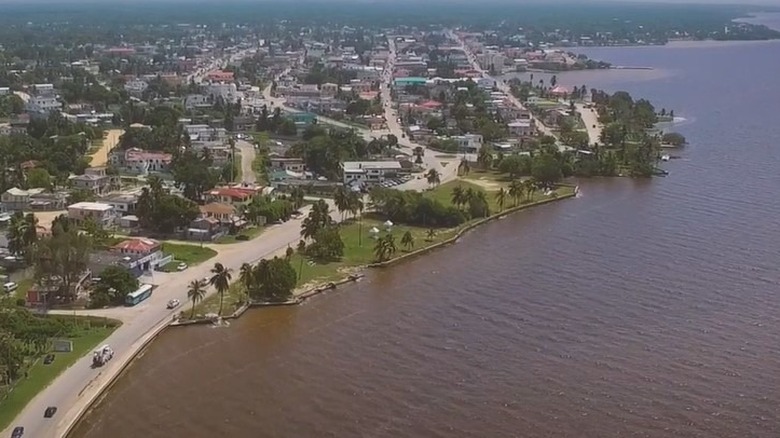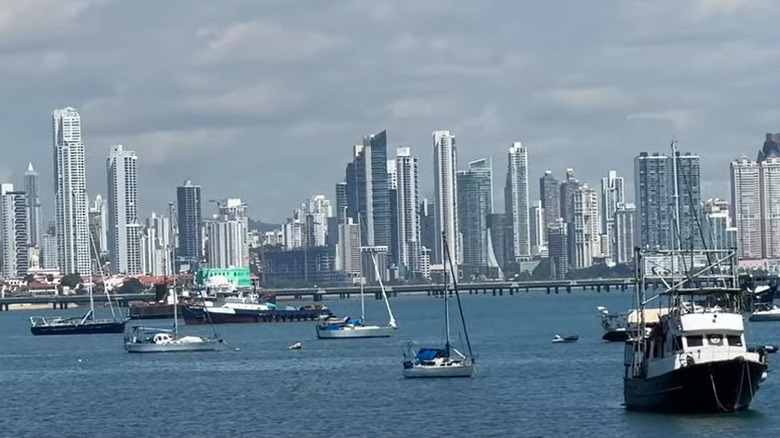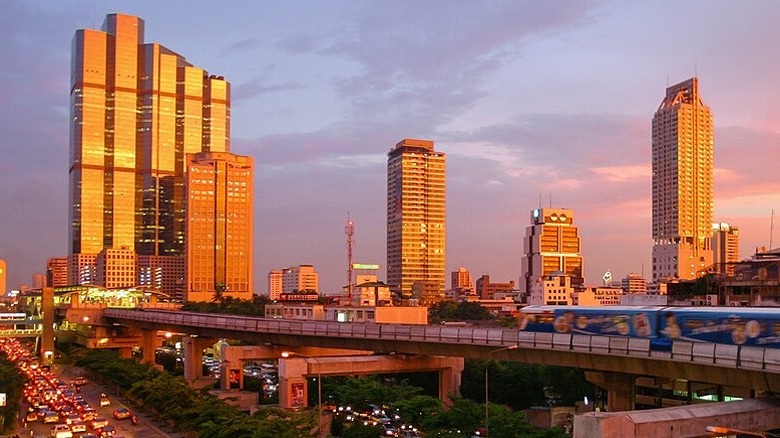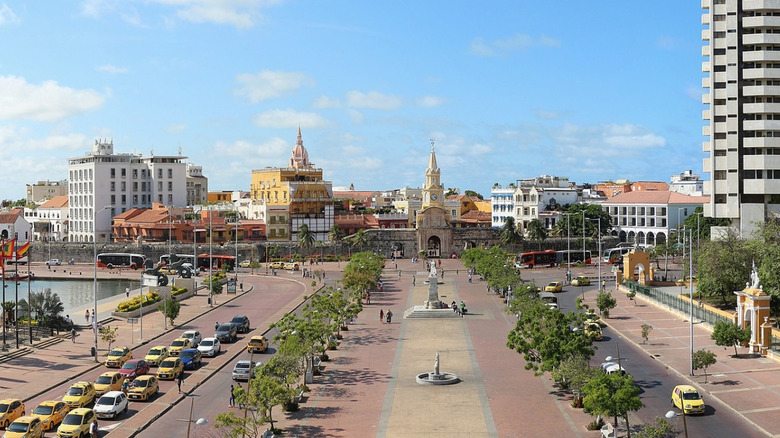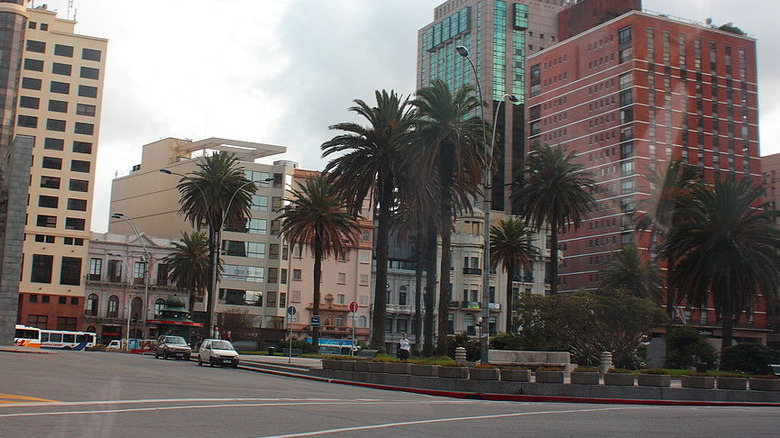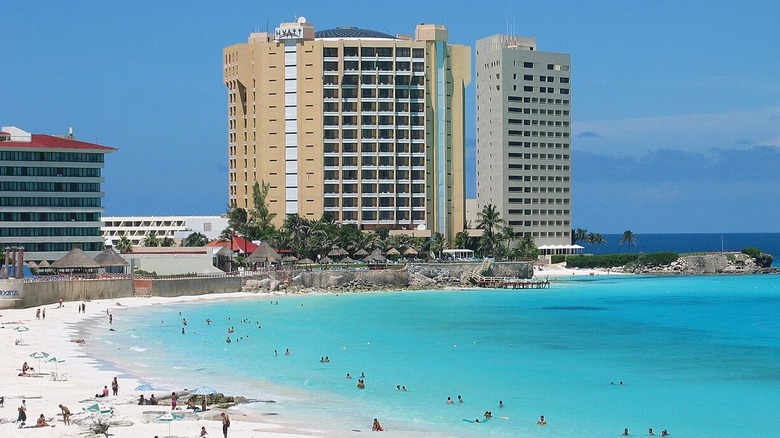The 15 Best Countries To Retire Outside The United States
Retirement is a time meant to be spent resting, relaxing, and enjoying a life without the everyday stresses associated with hard work and lengthy careers. Rather than remaining stateside, some Americans look into retiring abroad. The reasons for settling internationally can vary, but usually come down to a couple of reasons: cost and comfort. According to the U.S. Bureau of Labor Statistics, the average pre-tax income of a retired American was $48,870 as of 2022. Due to rising living costs across the United States, some retirement-age citizens express worry that their retirement savings won't be enough to cover basic needs, let alone a life of rest and leisure. While savings aren't a concern for everyone, at the very least, a growing number of retirees are settling down across the world in exotic locations that offer better weather and a more affordable life. Here are the 15 best countries for retirees planning to live abroad.
Vietnam may only cost retirees $500 per month
Vietnam is a popular destination for American retirees. Its larger cities of Ho Chi Minh City, Hanoi, and Da Nang have rental options for less than $300 per month, according to rental listing site FazWaz. For rural locations, housing costs could be even lower. The strength of the dollar relative to the Vietnamese dong (VND) makes everything from housing to healthcare relatively affordable. Some estimate that with a more frugal lifestyle, you will spend around $500 each month. Otherwise, life in this Southeast Asian destination should cost between $1,000 and $1,500 monthly, putting it well within the affordability range for most retirement-age Americans.
As for downsides, you may run into serious language barrier issues if you don't speak the language. There is also no visa option specifically dedicated to retirees. You would need to contact government officials to determine the most current visa options available for a long-term stay. Despite this lack of a straightforward path to retirement in Vietnam, many Americans have relocated there over the years and will likely continue to do so in the future.
The Dominican Republic is a great option for beaches and budgeting
Whether you're seeking to relax on the beaches of Punta Cana or wish to take in the historic grace of the capital city, Santo Domingo, the Dominican Republic offers permanent residence for seniors in the form of a retirement or pensioner's visa, sometimes called a "pensionado" visa. To qualify for this type of visa, you must submit a completed residency application form, a copy of your passport, an apostille copy of your birth certificate, and proof of retirement income averaging at least $1,500 per month; for dependents, you will need an additional $250 per month, per person. Before applying for this visa, you will need to sit for a medical exam and open a Dominican bank account. Likewise, you'll need to ensure that your passport is valid for at least a year before applying.
Though the warm weather, cost of living, and pathway to permanent residence are serious advantages for retirees looking to live in the Dominican Republic, there are a few disadvantages to keep in mind. The country is vulnerable to hurricanesand related flooding. The quality of healthcare services varies greatly across the country, especially in less-populated areas. If these aren't serious deterrents, then this Caribbean paradise may be just what you're looking for.
Portugal offers very affordable retirement visa program
Portugal was once an underestimated nation for those seeking a European retirement. Yet at least 10,000 Americans moved to Portugal between 2017 and 2022, up 239% from previous years, according to Forbes. The decision to move to Portugal isn't without its challenges. Though parts of the European country come with the perks of Mediterranean weather, this isn't true everywhere; some areas of the country can get quite cold. Moreover, if you don't know Portuguese, you might run into communication issues outside Lisbon and Porto. Still, if you are willing to embrace the challenges of life here, you may find Portugal to be a warm and welcoming new home for yourself and your fellow retirees.
Portugal provides a pathway to permanent residency through the Portugal Retirement Visa, also called the Portugal D7 Visa. There is currently no minimum age to qualify, though you must have a passive income of at least $1,016 per month. If you're looking to retire in Europe, Portugal is probably the most affordable and straightforward option.
Belize is a great choice for retirees new to life abroad
Belize is known for its beautiful beaches, majestic Mayan ruins, and a slower pace of life. Many locals speak English fluently, so you shouldn't have much difficulty communicating or making friends. Belize has a vibrant retiree community that has existed for years, making it easy to connect with fellow retired Americans and also find a knowledgeable support system for settling into Belizean life.
Belize offers a relatively straightforward path to permanent residence. To qualify, you must have already lived there for at least one year. You can't have left the country for more than 14 days in that time. You must share your proof of retirement income and evidence that you've not been convicted of any serious criminal offenses. The process includes submitting a series of documents, paying fees, and sitting for interviews. While lengthy, many consider the process worth it because Belize is a beautiful country with a relaxed lifestyle that is affordable to live in, but not necessarily with the level of culture shock you might experience if you relocate far from the U.S. to a place where no one speaks your language.
Greece is your gateway to Mediterranean-style retirement
If you are looking for a relaxed Mediterranean lifestyle, Greece could be the ideal place to settle down in retirement. Moving here means beautiful scenery, delicious Greek cuisine, and the ability to see ancient relics in Athens and other cities up close. The cost of living is relatively lower than in the United States, especially for those who settle in regions away from major cities and tourist destinations.
Although Greece doesn't have a retirement visa program, retired Americans still have a pathway to permanent residence through the Financially Independent Person (FIP) visa. However, it's worth noting that to qualify, Americans will need to show a minimum monthly retirement income of a little over $4,000 per month. For retirees who meet financial qualifications, Greece is not only a beautiful place to settle down in its own right, but its location makes it easy to travel to nearby European nations of interest.
Costa Rica lets you settle for as little as $1,000 per month
Costa Rica has become one of the premier destinations in for retirees from the United States wishing to explore life abroad. Not only is its weather generally warm all year long, but the U.S. dollar is an acceptable currency in the country. Likewise, you have multiple long-term visa options. First is the "pensionado" visa, which requires a monthly income of at least $1,000 per month. Alternatively, Costa Rica offers the Person of Independent Means or "Rentista" visa, for which you need retirement or pension income of at least $2,500 per month (you can also make a one-time payment of $60,000).
As straightforward as the process is to move to Costa Rica, it's important to consider some potential drawbacks. Namely, language barriers for non-Spanish speakers. Other concerns include areas of poor infrastructure, crime, and inconsistent access to higher-quality healthcare. Concerns aside, those who choose to move here generally find Costa Rica a welcoming and fun place to spend their time.
Panama has a thriving network of expat retirees
Panama has thriving expat communities, especially in the cities of Boquete and Coronado. These international networks have existed in the region for decades, making it possible to connect with like-minded retirees, even if you are relatively new to the nation. If you choose to be adventurous and relocate to areas of the country where you're not as likely to bump into a native English speaker, you will find that Panamanians are friendly and laid-back people, making it easy to adjust to a slower and more relaxed pace of life.
Like some other Central and South American countries, Panama has a "pensionado" program to help retirees move to and settle within its borders. You must demonstrate that your monthly earnings are at least $1,000, plus an additional $250 per dependent. Be aware that this application process will require that you provide key documentation such as notarized proof of income and a certified birth certificate. You'll also need to submit all paperwork in Panama through a lawyer. While this process could seem daunting, for as affordable and easy-going as life in Panama is, it will be well worth the time and effort.
Thailand offers affordable lifestyle and multiple visa options
Whether you want to take in the sunset along the Chao Phraya River in Bangkok or visit the famous rice fields of Chang Mai, Thailand is a pleasant region of Southeast Asia to spend your retirement. As with other notable destinations in the area, the dollar goes a long way, making it easy to find an affordable home to settle in for the long term. Thailand also offers a retirement visa program, specifically designed for those who intend to reside in the country for at least a year.
Retirees can choose between the Non-Immigrant Visa Category "O-A" visa or the Non-Immigrant "O-X" visa. The O-A visa covers a stay of at least a year, while the O-X visa is for those wishing to remain in the country for at least a decade. To qualify, you must be at least 50 years of age. You will also need to submit to a criminal background check, open a Thai bank account, and submit to a medical examination. Additionally, your monthly income should be at least $2,000 per month.
Colombia retirement could cut cost of living by almost half
Long gone are the days when Colombia was synonymous with danger and crime. Today, the country is better known for delicious coffee and being the home country of the famous singer Shakira. An ever-increasing number of U.S. retirees are flocking to the South American country, a place that's as much as 55.5% cheaper than life in the United States overall, according to My Life Elsewhere.
For those looking to live in Colombia long-term, there are several visas to choose from. Retirees should focus on the M-11 pensionado visa. The requirements are fairly simple compared to some other retirement visas. Your monthly social security, pension, or other income should be about $1,000 per month, representing three times the monthly average income of local Colombians. The visa is good for at least three years. The process could take a few weeks to a couple of months, depending on how long it takes you to gather all necessary documentation, as well as other specific requirements. Though with Americans relocating to Colombia by the thousands, it seems that many consider the visa process to be well worth the effort.
Malaysia promises lower cost of living, but with caveats
Malaysia might not be the first country that comes to mind for international retirement, but there is plenty for retirement-age Americans to love about this Southeast Asian destination. While there is a bustling metropolis in Kuala Lumpur, there are also beautiful beach resorts in Langkawi and the enchanting Perhentian Islands. Expats coming from the U.S. can take advantage of a much more affordable living standard. One study from 2022 found that life in Malaysia was about 51.74% more affordable than in America. With expenses continuing to climb stateside, it's possible that living in Malaysia will only become more affordable for retirees planning a move there.
Should you decide to live in Malaysia long-term, you could consider applying for the Malaysia My Second Home (MM2H) visa, though be aware that the "tiers" associated with this program require a deposit of at least $150,000. There are also a variety of steps and requirements that could make this visa program daunting compared to other retirement visas. If you are determined to live in Malaysia, it would be a good idea to work with a local lawyer to determine whether you qualify and what you need to complete the process. Should you take the leap, you will enjoy the benefits of a booming local economy without the high prices comparable to life in the United States.
Uruguay has economic stability and long-term visa access
Uruguay is yet another tropical South American destination for U.S. retirees who want to settle abroad. While some of its neighboring nations struggle with political controversy, economic strife, and unrest among their population, Uruguay has quietly settled into a reputation for overall stability and ease. In fact, Uruguay's overall standard of living is somewhat more expensive than most of South America, according to Guru'Guay. Still, relative to how expensive life can be in the United States for older Americans, Uruguay's costs and standard of living may be more affordable, with better weather to boot.
If you are interested in retiring in Uruguay, you may be able to apply for a long-term visa. You must have lived in Uruguay for at least three months to apply for permanent residency. You should also be able to prove you have a monthly pension or income of at least $1,500 per month. Once accepted, a pathway from permanent residency to Uruguayan citizenship opens up after successfully remaining in the country for at least three years if married or five years if single.
Italy offers Mediterranean lifestyle with a long-term visa plan
The romantic location, luscious Mediterranean weather, and beautiful ancient ruins all conspire to make Italy one of the most idealized countries for retirees hoping to settle abroad. For those relocating from America, International Living notes that life in Italy may be considerably less expensive, particularly for those hoping to buy a house or who want lower health insurance payments. However, you should be mindful that some items that are more plentiful stateside might cost more due to import taxes and fees. Nevertheless, if you have your heart set on settling down in Italy, the country does have a retirement visa program known as the Elective Residency Visa.
Those who apply for this visa cannot work in Italy, which is to be expected of retirees. However, you must have a stable income of at least 32,000 euros annually, equivalent to a little over $36,000 per year. When applying, make sure your passport is valid for at least three months beyond when you submit your completed form and fees. You'll need to present proof of your intent to remain in Italy long-term, the appropriate insurance coverage, and also a one-way flight reservation.
Canada brings familiarity, though with some challenges
For some, trading the United States for retirement in Canada is a no-brainer. As it is a neighboring country, it can feel far enough away to enjoy new life experiences, without being too far to visit friends and family. While some areas of Canada might not be quite as expensive as the bigger cities in the United States, its cost of living overall is still relatively close. In fact, food and groceries could be slightly more expensive, according to Western Union.
If you are simply looking for a change of scenery and expect your retirement income to cover life in Canada, it could be well worth applying for one of the available permanent residency programs. While there is no specific visa available for retirement-age immigrants, if you are of Canadian descent, married to a Canadian, or have other emergency circumstances, you could qualify for a permanent resident visa. Canada generally lets Americans stay there for up to six months at a time, depending on the arrangements made beforehand. If you prefer seasonal travel as part of your retirement lifestyle, you could opt to stay in Canada part-time.
Mexico offers retirees proximity and luxury
As with Canada, Mexico can appeal to retirees due to its proximity to the United States. Some might consider Cancun a must-visit destination, but some prefer to settle in Chetumal, which also has lovely beaches, but isn't nearly as crowded with seasonal visitors. Wherever you settle in Mexico, you will find the cost of living much lower than in the United States. You'll also be pleased with the quality of healthcare and related pricing.
If you want to retire in Mexico, you can apply for the "Residente Permanente" or Permanent Residency Visa. To qualify, you must be at least 64 years old and have proof of monthly income of at least $7,350. You also have the option to submit a one-time investment payment of around $292,000. You can instead opt for a temporary residence visa, which will let you reside in Mexico for a period between one and four years. To qualify, you'll need a monthly income of at least $4,400 or a one-time payment of about $73,647.00. You'll also need to submit supporting documentation proving your U.S. citizenship and legal status. You may be able to stay in Mexico for up to six months, depending on what immigration authorities decide.
Ireland has multiple visa options, including birthright
While some might opt for more romantic and chic destinations such as France or Italy as a retirement destination, Ireland is a somewhat underrated and yet no less beautiful European country for American retirees. For pensioners with more money to spend, the cost of living is comparable to life in America, though it costs about 3% less than in the United States on average, according to My Life Elsewhere. If you meet the minimum $58,000 (or about $116,000 for a couple) financial requirement to retire in Ireland, you can apply for the D Visa. If you successfully qualify for the D visa, you'll need to renew it annually for the first five years, after which you can potentially obtain a five-year visa. A less conventional pathway forward to permanent residency involves family lineage. If you were born in Ireland, have an Irish parent or grandparent, you may be able to successfully immigrate to Ireland through birthright citizenship.




